
I think Eiders, like most ducks, are just plain horny. I notice that at least one of them has very good borealis-type scapular sails, a favourite theme from Torry of course.

I think Eiders, like most ducks, are just plain horny. I notice that at least one of them has very good borealis-type scapular sails, a favourite theme from Torry of course.

You're going to have to help me out here, Andrew. Which photo, which duck, what are scapular sails, and what is the significance of borealis?
I've seen the comments in Birds fae Torry, but have never understood what you were all banging on about. Maybe now I'll find out.
Best wishes,
Dave Kennedy
The third picture maybe shows it best. Look at the drake in the front centre that's sideways on and looking towards the female. He has a pair of obvious white 'sails' on his back, a bit like on a fairy cake. These aren't normally found on British birds but are usually present on birds of the northern borealis subspecies, which breeds in areas like Greenland. It seems that a small proportion of British birds do show these though, so it's perhaps not as diagnostic of borealis as was once thought.

Andrew, thanks for this info. Much appreciated. "Birds of Britain and Europe" states that S.m. borealis has a yellow/orange bill. Are you and your Aberdeen pals suggesting that the birds you are seeing with scapular sails are hybrids with borealis?
Best wishes,
Dave
There may be some pure borealis about in the northeast, but I and others suspect that most birds showing sails are hybrids or intergrades. There's a lot more about borealis ID here, although maybe it's a little out of date now:

Interesting, Andrew, and thank you for that URL. Good illustrations too. There is little sign of an orange bill in the Kintyre birds, but the sails are definitely there. So - they occur in Aberdeen and in Kintyre. Do you have information from other parts of the country about these sailed eiders and the significance, if any, thereof? I guess the thing to do is start looking for an orange beak as well.
I'll keep my eye on Birds fae Torry to see what you come up with.
Best wishes,
Dave

The first one I ever saw had a very bright orange bill, but otherwise the ones I've seen in Aberdeen are within the normal range of British Eiders. Eiders with sails have certainly been reported in the Western and Northern Isles and, as the Martin Garner article illustrates, Ireland. I expect that scrutiny of any Eider flocks in the UK and Ireland will eventually reveal a few.
Definitely a Great-northern Dave.
Off to Campbeltown on Sunday for a few days and looking forward to doing some birding.
ATB
Stewart
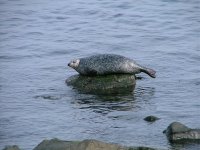
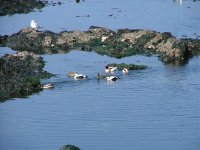
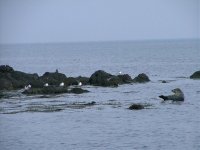
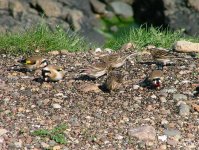
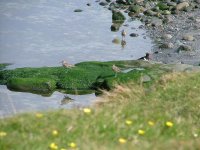
Hi Dave,Right, then, back to Machrihanish and its wildlife. Mammals seen by us in the area include otter, seal, rabbit, wild goat, and stoat (which we saw catching a rabbit). Birds which we have seen (depending upon season) include, inter alia, Oystercatcher, Sandwich Tern, Arctic Skua, Greater Black-backed Gull, Herring Gull, Common Gull, Manx Shearwater, Gannet, Twite, Goldfinch, Linnet, Wheatear, Peregrine, Whimbrel, Shelduck, Long-tailed Duck, Mallard, Eider, Great Northern Diver, Hooded Crow, Starling, Rock Pipit, Redshank, Ringed Plover, Guillemot, Razorbill, Shag, Cormorant, Pied Wagtail, Lesser Black-backed Gull, Greenfinch, and Wigeon. Records from the Observatory include, besides the above, Purple Sandpiper, Red-throated Diver, Black Guillemot, and Golden Eagle, with regular passage migrants such as Storm Petrel, Sooty Shearwater, Black-throated Diver, Scaup, Golden Plover, White-fronted, Barnacle, Brent and Greylag Geese. Uisaed Point is at its best when strong west to north-west winds force the birds closer to shore.
This series of photographs ranges from the little bay in front of Machrihanish village, past the small bay with the wee white house, to the Observatory on Uisaed Point.
The first picture shows a common seal dozing on a rock in the bay. They don't look like much when you see them like this......but come when the blood runs hot and the seals are courting, and you will see a swimming display of such fire and athleticism that you will be astonished.
In the second photograph, again in the little bay, there was some serious interaction between three duck species, mallard, eider and shelduck. If any of you have any insight as to why they seemed to be disputing that small pool, please respond.
Next, there is a small group of rather distant Sandwich Terns dozing on a rock under the benign gaze of an idle seal. This rock is on the western side of the little bay in front of Machrihanish village, and is used by the terns every year.
The fourth picture was taken from the Observatory, and shows Goldfinch and Twite. The pink rump of the male Twite is clearly visible.
Finally, there are (if you look carefully), three and a half Whimbrels and an Oystercatcher relaxing in the little bay with the wee white house. Whimbrel are passage migrants through this area.
All the photographs were taken in April 2009.
It's a superb area, and well worth investigating.
Best wishes,
Dave Kennedy
Hi Dave,
I'm off upto Argyll in august for a week and will definatly be dropping in on Eddie at Machrahanish, its many years since i went up there and learned quite a bit off Eddie when we gave him a lift in the back of our car back to Cambletown (He can certainly talk)LoL
Your right about it being a great place for wildlife I'm disabled and although i cannot walk far the amount of wildlife spotted just from the car was amazing! This time i will be armed with lots of camera gear so hopefully bring back some shots.
Cheerio
Brian

Hi Dave,
I'm off upto Argyll in august for a week and will definatly be dropping in on Eddie at Machrahanish, its many years since i went up there and learned quite a bit off Eddie when we gave him a lift in the back of our car back to Cambletown (He can certainly talk)LoL
Your right about it being a great place for wildlife I'm disabled and although i cannot walk far the amount of wildlife spotted just from the car was amazing! This time i will be armed with lots of camera gear so hopefully bring back some shots.
Cheerio
Brian
